Dust-free diatomaceous earth application involves mixing the powder with water before spraying instead of applying it dry. You’ll eliminate dangerous airborne dust clouds that cause lung irritation and pose inhalation risks by creating a wet solution using 4 tablespoons of food-grade diatomaceous earth per gallon of water. This method guarantees even coverage on plants while protecting your respiratory system and eyes from irritation. The solution dries within 2-4 hours and maintains its pest-control effectiveness once dried, providing safer application results for thorough pest management strategies.
Understanding Diatomaceous Earth Composition and Properties
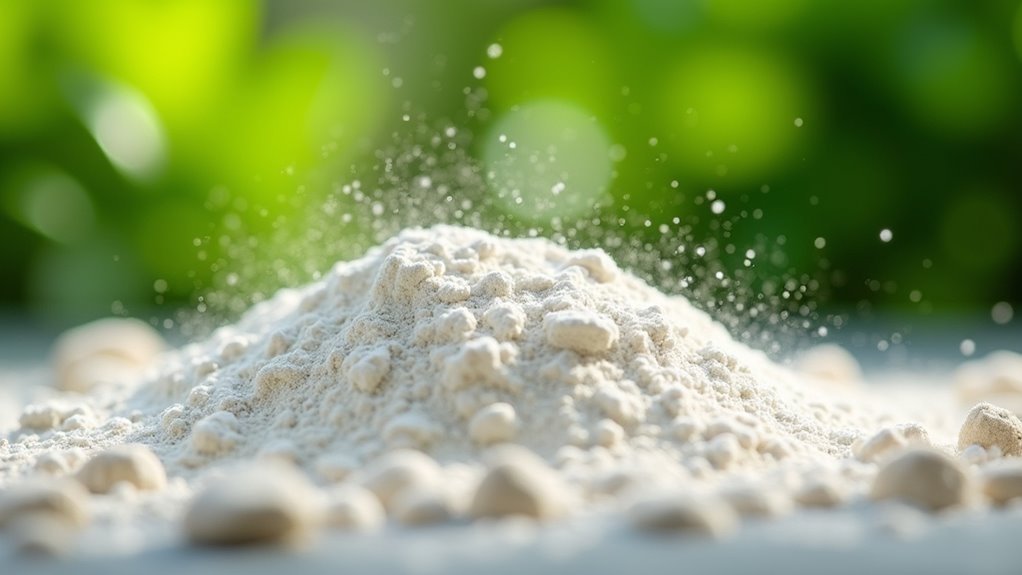
Millions of microscopic diatoms lived and died in ancient oceans, leaving behind their silica-rich skeletal remains that we now harvest as diatomaceous earth.
You’re working with fossilized organisms that consist primarily of amorphous silicon dioxide, which makes up about 26% of earth’s crust by weight. This silica-rich structure gives DE its unique abrasive properties that damage pest exoskeletons, causing dehydration and death.
You’ll find two main grades available: food grade diatomaceous earth, which is safe for consumption, and industrial-grade for filtration applications.
The amorphous form you want is non-toxic and won’t accumulate in your body, unlike crystalline forms that pose respiratory risks. Since diatomaceous earth isn’t water-soluble, it maintains effectiveness until moisture or cleaning removes it.
Safety Hazards of Traditional Dry Application Methods
While diatomaceous earth offers effective pest control, traditional dry application methods create significant safety concerns that you can’t ignore.
The primary safety hazards stem from airborne dust clouds that form during application. These fine particles pose serious inhalation risks, potentially irritating your lungs and respiratory system. Industrial-grade formulations present even greater dangers, potentially causing long-term lung damage with repeated exposure.
| Safety Concern | Immediate Effects | Long-term Risks |
|---|---|---|
| Respiratory | Lung irritation, coughing | Potential lung damage |
| Skin/Eyes | Irritation, burning sensation | Chronic sensitivity |
| Environmental | Dust dispersion, pet exposure | Ecosystem disruption |
| Application | Poor visibility, uneven coverage | Beneficial insect harm |
Wind conditions worsen these problems by spreading dust beyond intended areas, requiring protective equipment like masks, goggles, and gloves for safe handling.
Wet Application Technique for Dust-Free Results
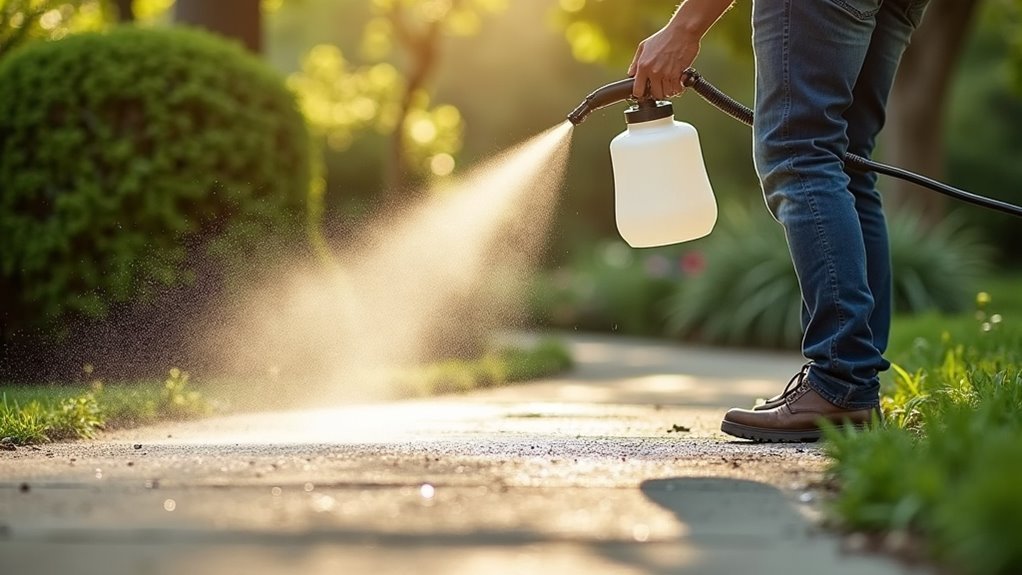
You’ll need to mix 4 tablespoons of food-grade diatomaceous earth with 1 gallon of water to create an effective spray solution.
This mixture eliminates the dust clouds that make dry application hazardous while ensuring even coverage across all plant surfaces.
Once you’ve applied the wet mixture, let it dry completely to form a protective barrier that stays put better than dry powder.
Water Mixing Ratios
Four tablespoons of food-grade diatomaceous earth mixed with one gallon of water creates the ideal spray solution for dust-free application.
These precise water mixing ratios guarantee you’ll achieve the best coverage without respiratory concerns associated with dry powder methods.
Mix thoroughly until the diatomaceous earth completely suspends in the water, preventing settling that could reduce effectiveness.
You’ll want to stir frequently during application to maintain even distribution throughout your spray session.
When you apply diatomaceous earth using this wet method, target all plant surfaces including undersides of leaves where pests often hide.
The solution must dry completely on plants to form an effective barrier.
You’ll need to reapply after rain or heavy moisture events to maintain continuous pest protection and maximize your results.
Drying Time Requirements
After applying your diatomaceous earth solution, the treated surfaces must dry completely to form an effective pest barrier—a process that typically requires 2-4 hours under normal conditions.
The drying time requirements for your wet application technique depend heavily on environmental factors like humidity, temperature, wind, and sunlight exposure.
You’ll achieve ideal results by applying the mixture during cooler periods—early morning or late evening—when humidity levels support proper drying.
Keep the fine layer wet during application to guarantee proper surface adhesion and prevent airborne dust particles.
Monitor treated areas periodically after application. If surfaces become re-wetted from moisture, you’ll need to reapply the solution.
Proper drying guarantees the diatomaceous earth maintains its pest control effectiveness while remaining dust-free.
Specialized Equipment for Controlled Distribution
You’ll find that professional applicator systems transform diatomaceous earth distribution from a messy chore into a precise operation.
These systems feature precision dosing equipment that lets you control exactly how much material you’re applying to each area.
Most quality units include anti-drift technology features that prevent the powder from scattering beyond your target zone, keeping your application contained and effective.
Professional Applicator Systems
Professional applicator systems represent a significant advancement in dust-free diatomaceous earth distribution, utilizing specialized equipment like electrostatic sprayers and pneumatic applicators to deliver controlled, even coverage without creating hazardous airborne particles.
These systems apply diatomaceous earth in dampened form, eliminating inhalation risks while maintaining effectiveness against pests.
You’ll benefit from several key features that enhance application efficiency:
- Wide coverage capability – treating thousands of square feet in single passes across large properties
- Adjustable spray nozzles – customizing droplet size and patterns for precise pest targeting
- Reduced product waste – ensuring ideal adhesion to surfaces without over-application
- Enhanced safety protocols – protecting users and surrounding areas from dust exposure
- Professional-grade precision – delivering consistent results through specialized pneumatic technology
These professional applicator systems maximize your diatomaceous earth investment while prioritizing safety.
Precision Dosing Equipment
Beyond large-scale professional systems, precision dosing equipment offers targeted control for smaller applications where accuracy matters most. These specialized dusters and sprayers let you apply diatomaceous earth with exact measurements while preventing airborne particles. You’ll find adjustable flow controls that customize dispensing amounts, ensuring efficient coverage without waste.
| Feature | Benefit | Application |
|---|---|---|
| Adjustable Controls | Customized dosing | Targeted pest areas |
| Ergonomic Design | Easy handling | Hard-to-reach spaces |
| Air Pressure System | Fine mist coverage | Reduced environmental drift |
| Dust-Free Operation | Minimal airborne particles | Indoor applications |
Many models include ergonomic handles and lightweight construction, making elevated applications manageable. Some incorporate fan mechanisms that create fine mists, enhancing coverage while reducing environmental impact. Using precision dosing equipment improves pest control effectiveness by delivering diatomaceous earth exactly where needed without over-application.
Anti-Drift Technology Features
When controlling diatomaceous earth distribution, anti-drift technology transforms how you manage airborne particles through specialized nozzle designs and pressure regulation systems.
These advanced features guarantee your dust-free diatomaceous earth reaches intended targets while protecting surrounding areas from contamination.
Modern anti-drift technology incorporates several key components that enhance application precision:
- Adjustable nozzles that create controlled spray patterns for targeted pest zones
- Low-pressure delivery systems that maintain product integrity during application
- Moisture sensors that detect ideal environmental conditions for maximum effectiveness
- Drift-reduction chambers that contain particles within designated treatment areas
- Variable flow controls that adapt application rates to specific pest situations
You’ll experience improved pest control efficiency as the technology directs diatomaceous earth exactly where needed, reducing waste and minimizing impact on beneficial insects and wildlife in your treatment area.
Proper Dilution Ratios for Liquid Applications
Four tablespoons of diatomaceous earth mixed with one gallon of water creates the ideal liquid application that’ll give you effective pest control without the mess of dry powder.
These proper dilution ratios for liquid applications guarantee you’re applying just enough active ingredient without wasting product or creating runoff.
Precise mixing ratios ensure maximum pest control effectiveness while preventing product waste and harmful chemical runoff in your garden.
You’ll need to agitate the mixture thoroughly before spraying to maintain even distribution throughout your solution.
The fine spray pattern allows complete surface coverage without excessive dripping that reduces effectiveness.
Apply your diluted mixture during early morning or evening hours when higher humidity helps the solution adhere better to plant surfaces.
After heavy rains or when you notice renewed pest activity, you’ll need to reapply since moisture washes away the protective coating.
Garden Duster Tools and Precision Applicators
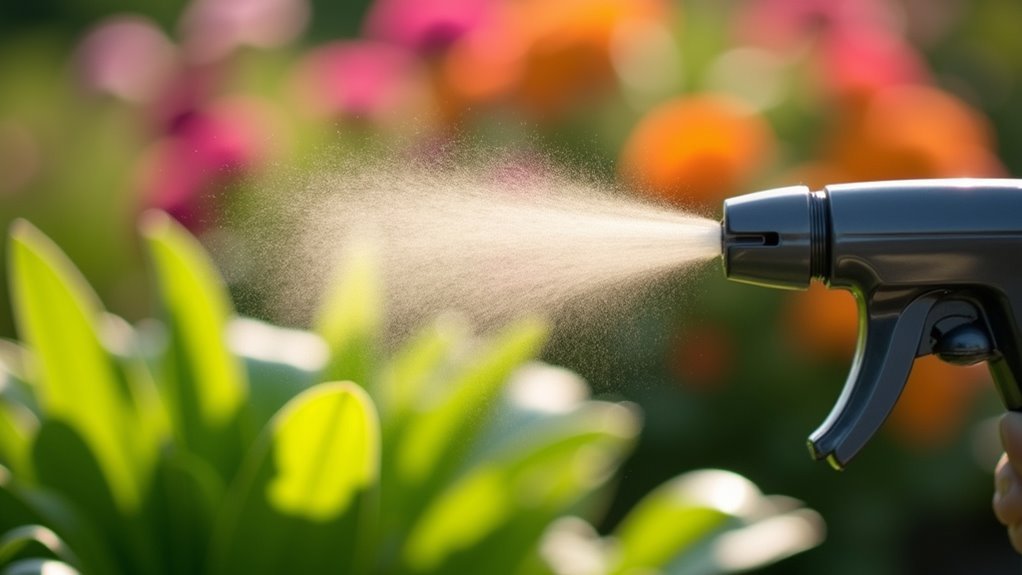
While liquid applications work well for many situations, garden dusters and precision applicators give you superior control when applying dry diatomaceous earth to your plants and soil.
These specialized tools guarantee even distribution while minimizing dust clouds that can irritate your respiratory system.
Garden dusters feature adjustable nozzles that let you control flow rates and target specific areas without waste. You’ll appreciate their built-in filters that prevent clogging and maintain consistent particle distribution.
The lightweight, ergonomic designs reduce fatigue during extended applications.
- Fine powder settling gently on tomato leaves like morning dew
- Precise streams reaching hidden pest hideouts beneath plant canopies
- Smooth trigger action delivering controlled bursts around garden beds
- Filtered airflow creating uniform coverage across vegetable rows
- Comfortable grip supporting steady hands during detailed application work
Protective Gear Requirements During Application
Proper safety equipment protects you from diatomaceous earth’s fine particles that can irritate your respiratory system, eyes, and skin during application.
You’ll need a mask or respirator as your primary protective gear to prevent inhaling dust particles that can harm your lungs. Wear protective eyewear to shield your eyes from irritating particles during the application process.
Don’t forget gloves when you apply diatomaceous earth, especially if you have sensitive skin or allergies. Cover exposed skin with long sleeves and pants to minimize contact with the powder.
Guarantee proper ventilation in your work area to reduce dust accumulation and lower inhalation risks. This is particularly vital when working in enclosed spaces where particles can concentrate and create hazardous breathing conditions.
Weather Conditions for Optimal Dust-Free Treatment
Beyond wearing the right protective equipment, timing your diatomaceous earth application according to weather conditions dramatically impacts its effectiveness and helps minimize airborne dust.
Applying diatomaceous earth during suitable weather guarantees better coverage and reduces waste from wind dispersal.
Choose mild, dry conditions for dust-free diatomaceous earth application to prevent powder clumping and guarantee even distribution.
Apply during early morning or late evening when dew provides natural moisture for better surface adherence.
Avoid windy days that’ll scatter the powder and reduce targeted effectiveness.
Key weather considerations include:
- Morning dew glistening on plants enhances powder adhesion
- Gentle breezes rustling leaves indicate manageable wind conditions
- Clear, sunny skies promising extended dry periods
- Calm air allowing precise placement without drift
- Stable atmospheric pressure maintaining settled conditions
Reapply after heavy rainfall washes away the treatment.
Surface Preparation Before Application
You’ll need to thoroughly clean your target areas before applying dust-free diatomaceous earth to guarantee maximum effectiveness.
Remove all debris, organic matter, and existing pest materials that could interfere with proper adhesion.
Check moisture levels carefully since wet surfaces will cause the D.E. to clump rather than spread evenly across the treatment area.
Clean Target Areas
Before you apply dust-free diatomaceous earth, you’ll need to thoroughly clean target areas to ascertain maximum effectiveness. Proper preparation guarantees the powder adheres correctly and works efficiently where diatomaceous earth is used for pest control.
Start by removing all debris, dirt, and moisture from surfaces. Sweep or vacuum thoroughly to eliminate existing insects, eggs, and residues that could interfere with application. For outdoor spaces, clear away organic matter like leaves or mulch that shelter pests.
- Sweeping concrete patios free of spider webs and dust particles
- Vacuuming carpet edges where ants commonly travel
- Wiping down kitchen counters with a clean, dry cloth
- Removing wet leaves from garden pathways before treatment
- Brushing away old insect debris from windowsills and door frames
This preparation creates ideal conditions for effective pest elimination.
Moisture Level Check
One critical step that determines your diatomaceous earth’s success involves checking moisture levels on all target surfaces.
You’ll need to verify surfaces feel completely dry to touch before application, as dampness prevents proper powder adhesion to insects. Conduct a thorough moisture level check using a moisture meter or visual inspection around potential problem areas.
For outdoor applications, examine surfaces for dew or recent rainfall effects that could compromise results.
Indoor spaces require special attention near sinks, stoves, and other moisture sources where humidity accumulates. You can’t expect ideal pest control when applying diatomaceous earth to wet surfaces.
Maintaining dry conditions during application extends the powder’s active period, ensuring maximum effectiveness against target pests while preserving the product’s pest-fighting properties.
Mixing Solutions for Spray Applications
When applying diatomaceous earth as a liquid solution, you’ll create an effective dust-free alternative by mixing 4 tablespoons (59 ml) of food-grade diatomaceous earth with 1 gallon (3.8 L) of water. This ratio guarantees ideal coverage while maintaining the pest control properties you need.
Proper preparation of mixing solutions requires thorough blending to prevent clumping and achieve even distribution. Stir vigorously until the diatomaceous earth dissolves completely into the water, creating a smooth slurry ready for application.
- White powder swirling into clear water like chalk dust
- Garden sprayer filled with milky-white protective solution
- Fine mist coating green plant leaves evenly
- Droplets settling on pest-prone surfaces and stems
- Dried residue creating invisible protective barriers
Use garden pump sprayers or spray bottles for best results.
Application Pattern Techniques for Even Coverage
You’ll achieve the best results by applying diatomaceous earth in overlapping passes rather than concentrating on single spots.
Start with a light, even dusting at the recommended coverage rate, then build up layers gradually if needed.
Focus on creating systematic patterns that guarantee you don’t miss areas while avoiding over-application that wastes product and creates unnecessary buildup.
Uniform Distribution Methods
Several application tools can help you achieve even coverage when distributing diatomaceous earth across targeted surfaces.
You’ll want to select equipment that creates uniform distribution while minimizing waste and maximizing effectiveness against pests.
When you apply diatomaceous earth in dry form, aim for light dusting that doesn’t clump.
For wet applications, mix the product with water and use spray equipment to guarantee thorough coverage before the mixture dries.
- Garden duster releasing fine powder particles across garden beds like morning mist
- Flour sifter creating delicate, snow-like layers over surfaces
- Shaker can dispensing controlled amounts like salt from a restaurant container
- Pump sprayer coating areas with wet mixture like gentle rainfall
- Specialized applicator distributing precise quantities across large landscapes
Always apply during calm weather conditions, preferably early morning or evening, for ideal adhesion.
Coverage Rate Guidelines
Proper coverage rates determine how effectively diatomaceous earth controls pests while avoiding wasteful over-application.
You’ll achieve ideal results by following the established coverage rate of approximately 1,800 square feet per 4.4-lb container. This translates to roughly 2.4 pounds per 1,000 square feet, ensuring you’re applying just enough product without creating wasteful clumps.
Focus on creating a light, even layer across target surfaces rather than heavy concentrations in specific areas.
The key to effective diatomaceous earth application lies in uniform distribution – you want a barely visible dusting that covers all potential pest hiding spots.
Remember that a thin, consistent layer performs better than thick deposits, which can actually repel insects rather than allowing them to walk through the powder and become affected.
Monitoring Effectiveness After Dust-Free Treatment
How can you tell if your dust-free diatomaceous earth treatment is actually working? Monitoring effectiveness requires consistent observation and documentation.
Success with dust-free diatomaceous earth depends on careful monitoring and keeping detailed records of your pest control progress.
You’ll need to check treated areas every few days, looking for visible signs of reduced pest populations and changes in behavior patterns. Track your progress by noting specific locations where you previously spotted infestations.
When you apply dust-free diatomaceous earth, remember that weather conditions affect its longevity—reapply after rain or strong winds that disperse the treatment.
- Dead insects clustered near application zones
- Fewer pest sightings in previously infested areas
- Reduced damage to plants or stored materials
- Changes in pest movement patterns and hiding spots
- Decreased pest droppings or other activity signs
Maintain detailed records of application dates and pest observations for long-term assessment.
Reapplication Schedules and Maintenance
Since diatomaceous earth’s effectiveness diminishes when exposed to moisture and environmental factors, you’ll need to establish a consistent reapplication schedule to maintain pest control.
Apply fresh diatomaceous earth every three days or immediately after rain, as water considerably reduces its pest-fighting capabilities.
Monitor treated areas regularly by visually checking if the powder remains visible and active. If it’s settled into soil or washed away, reapply immediately.
During high-pest seasons, maintain stricter reapplication schedules to prevent infestations from gaining momentum.
Always apply during dry conditions for maximum effectiveness, though wet applications work when targeting specific plants.
Remove organic debris like pet waste from treated zones to prevent reinfestation.
Consistent maintenance and proper timing guarantee diatomaceous earth remains an effective component of your integrated pest management strategy.
Cleanup and Storage of Equipment After Use
Clean your diatomaceous earth application equipment immediately after each use to prevent powder buildup and maintain peak performance.
Proper cleanup and storage protect your investment while ensuring safe, effective future applications.
Maintaining your equipment through proper care ensures reliable performance and extends the lifespan of your diatomaceous earth application tools.
- Thoroughly rinse dusters and spray bottles with warm water, watching white powder swirl down the drain until water runs completely clear.
- Wipe down all surfaces that contacted DE with a damp cloth, removing every trace of fine powder residue.
- Store cleaned equipment in a dry location away from moisture and humidity that could cause rust or corrosion.
- Keep leftover DE in airtight containers within cool, dry spaces to prevent clumping and preserve effectiveness.
- Wash your hands and exposed skin immediately after handling equipment to avoid irritation and maintain hygiene.
Frequently Asked Questions
How to Apply Diatomaceous Earth Without a Duster?
You can mix four tablespoons of food-grade diatomaceous earth with one gallon of water in a spray bottle, or use an old spice shaker to sprinkle the dry powder evenly.
Is It Safe to Sleep in the Same Room as Diatomaceous Earth?
You can safely sleep in a room with properly applied food-grade diatomaceous earth. Guarantee good ventilation, avoid large dust piles, and let particles settle before sleeping to minimize respiratory irritation.
What Bugs Are Killed by Diatomaceous Earth?
You’ll find diatomaceous earth kills ants, bed bugs, fleas, cockroaches, silverfish, slugs, beetles, aphids, and earwigs. It damages their exoskeletons and dehydrates them by absorbing oils from their bodies.
What Does Diatomaceous Earth Do to the Human Body?
When you ingest food-grade diatomaceous earth, your body quickly excretes it since it’s minimally absorbed. However, you’ll experience irritation if you inhale it, potentially causing respiratory issues and mild lung inflammation.
In Summary
You’ve learned that dust-free diatomaceous earth application protects your health while maintaining effectiveness. By using wet application methods, proper dilution ratios, and specialized equipment, you’ll achieve even coverage without respiratory risks. Don’t forget to monitor your treatment’s success and follow reapplication schedules. Clean and store your equipment properly after each use. You’re now equipped to apply diatomaceous earth safely and effectively in any environment.


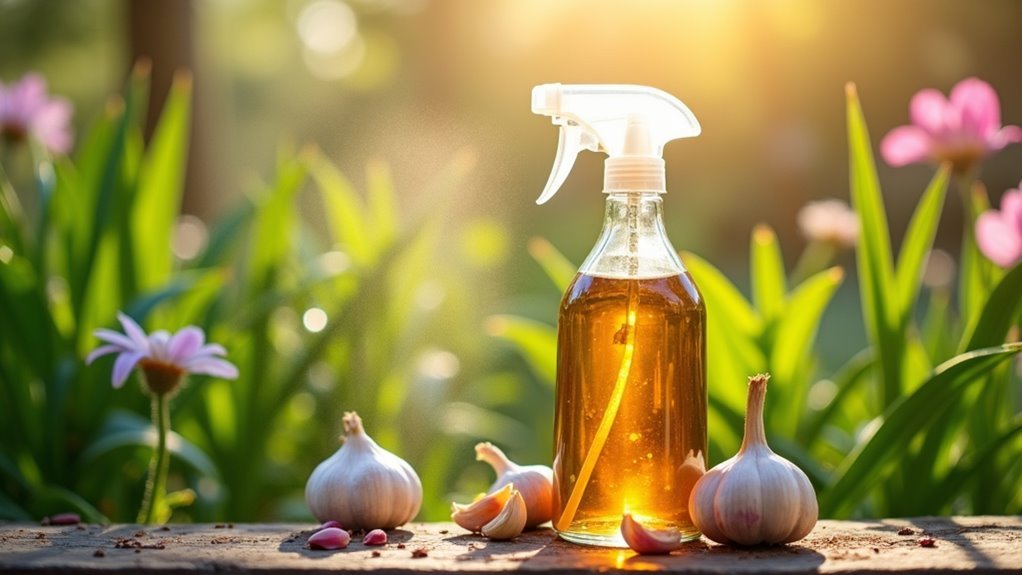

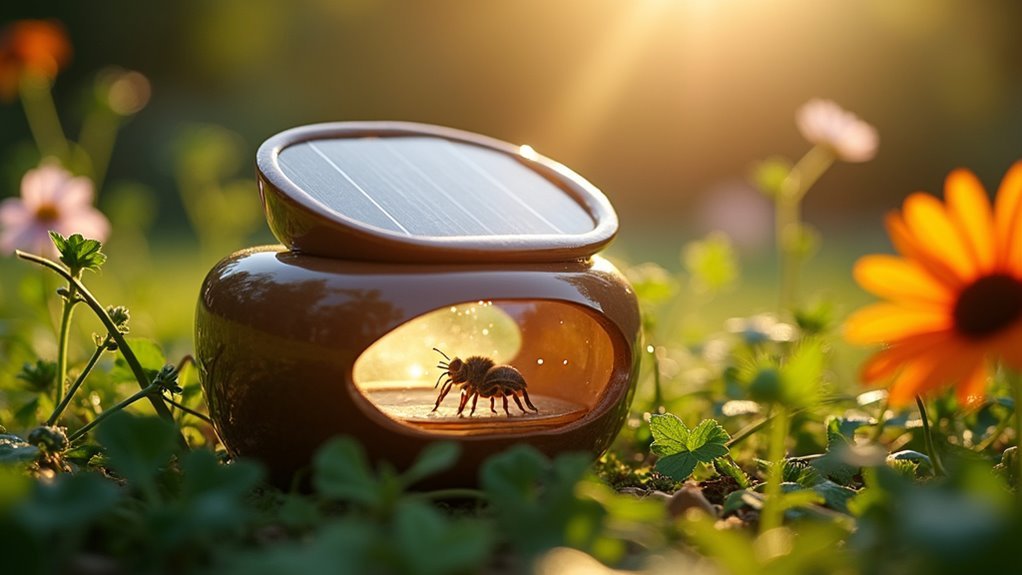
Leave a Reply